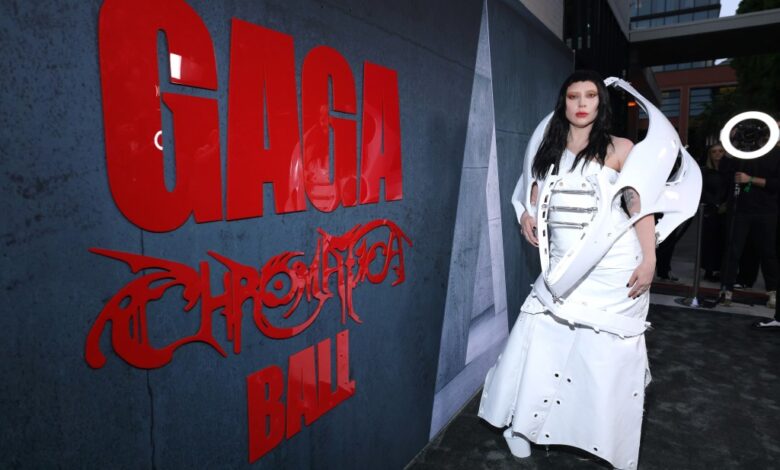Lady Gaga Debuts ‘Chromatica Ball’ Film at L.A. Premiere, Reveals She Played Five Shows with COVID

Rocking black hair, bleached eyebrows and a white ensemble that she said was meant to resemble a car part, Lady Gaga debuted her Gaga Chromatica Ball concert special in her signature style on Thursday night, with a premiere screening in Los Angeles for her fans.
The concert film follows Gaga during the Los Angeles stop of her 2022 Chromatica Ball Tour, as she takes over Dodger Stadium with both her biggest hits and new songs from her 2020 album Chromatica. It was Gaga’s first all-stadium tour and was comprised of just 20 dates, starting in Germany in July 2022 and ending two months later in Miami.
At the premiere event, Gaga — who made a quick change after the red carpet into a black outfit featuring a sparkling mask — sat down for a short Q&A with Access Hollywood‘s Scott Evans ahead of the screening. Guests were told in advance it would be a standing-room-only event and dancing was encouraged during the film.
“I’m so incredibly lucky to be here with all of you. I’m so excited,” Gaga told the crowd, comprised of several hundred fans. “This was such a special time. This tour went on during a time that people didn’t think that you could tour [amid the pandemic] and stadiums were packed all over the world and they were sold out, all dressed up and dancing and singing. I’m just so excited for you all to see what we made up close.”
The star revealed during the chat that she “did five shows with COVID,” explaining, “I shared it with everyone on my team. I said, ‘I don’t want anyone to feel uncomfortable at work and you don’t have to perform and you don’t have to work that day, but I’m going to do the show’ because I just didn’t want to let all the fans down. And the way that I saw it also is like the fans were all putting themselves in harm’s way every day coming to the show.”
Reflecting on the tour, Gaga said that both it and the album “in a lot of ways was the end of a time of my life and the beginning of a totally new one. And I feel like that time is actually maybe a few albums of time that I was sort of saying goodbye to old wounds or scars or challenges and with this tour, I felt really renewed to do something entirely different.” She noted that the aesthetic of the tour was quite different from the album, admitting, “I think I felt brave enough to embrace this brutalist aesthetic in a way that I wasn’t brave enough to do when I first put the album out.”
She also discussed the show’s unique fashion and stage design, choreography — joking “this was the first tour I’ve ever done in flats” — and “Babylon” being the most difficult song to perform.
Of choosing to release this specific tour as a concert film, Gaga explained, “I felt like the Chromatica Ball was a time where I took myself to the next level and it was something worth documenting and seeing for people that I love — not that I didn’t love my other tours. I’m sure we all can relate to that feeling of when you personally feel proud of something is really different from when everyone around you feels that way.”
“I think personal passion is really kind of a private experience,” she continued. “I’m sure there’s lots of tours and albums that I’ve been a part of that you all would have loved to have seen up close, and I’m sorry for the ones that you didn’t have. But I hope that you know that what you’re about to watch, I stand by this with everything.”

Lady Gaga and Scott Evans speak onstage
David Jon/Getty Images for HBO
The star teased that currently she’s “in the studio every single day. I have written so many songs, I’ve been producing so many songs, and it’s nothing like anything that I’ve ever made before. I love to break genre and I love to explore music. There’s something really beautiful about knowing that you will be loved no matter what you do,” she said, thanking everyone in the audience for making her feel that way. Gaga added of this moment in her creative journey that “something I’m definitely exploring right now is sort of the art of intensity and I think that the art of intensity actually began during this tour. But I’m not done with it yet.”
Following the Q&A, fans danced it out to the film, while also stopping to take pictures at an accompanying exhibit featuring many of her costumes from the tour. Gaga Chromatica Ball premieres Saturday on HBO and will be available to stream on Max.


